County Gaol and Bridewell, Oxford, Oxfordshire
The Oxfordshire County Gaol was established in the thirteenth century at the site of Oxford Castle, which was itself erected in 1071 with a motte and bailey design.
In 1784, John Howard wrote:
COUNTY GAOL, OXFORD CASTLE, OXFORD.
GAOLER, Solomon Wisdom.
Salary, £20.
Fees, Debtors, £0 : 9 : 2.
Felons, £0 : 15 : 10.
Transports, He made a bill of the expence.
Licence, Beer and Wine.
PRISONERS,
Allowance, Debtors, none.
Felons, County, 16d. each per week in bread; City, 1s.
Garnish, cancelled.
Number,
| Debtors. | Felons &c. | Debtors. | Felons &c. | ||
| 1773, Nov. 26, | 14, | 13. | 1779, Feb. 25, | 12, | 15. |
| 1774, July 4, | 11, | 17. | 1779, July 29, | 13, | 4. |
| 1776, Jan. 2, | 13, | 10. | 1782, April 28, | 16, | 10. |
| 1776, Oct. 31, | 7, | 14. | 1782, Dec. 25, | 25, | 31. |
CHAPLAIN, Rev. Mr. Swinton, now Rev. Mr. Cotton.
Duty, Sunday, Wednesday, Friday; the sacrament four times a year.
Salary, £50, now £40.
SURGEON, Mr. Rawlins.
Salary, £25 for felons.
Debtors, Felons &c. Debtors, Felons &c.
FOR the castle gaol the county pays £40 a year to Mr. Etty, who holds it of Christ church college on lease. Debtors apartments small; and not enough of them for the general number of prisoners. No free ward: for lodging even in the tower on their own beds they must pay 1s. 6d. a week. Their court is too small. Felons day-room or hall for men and women down 5 steps, 23 feet by 11, the men's dungeon (18½ feet by 16½), down 5 more; only small apertures: the women's night-room 6; feet by 4 feet 2 inches. The court common to both, 29 feet by 23. The gaoler has a spacious garden.
Since the north-gate was taken down, this prison has been also the City gaol: for which Mr. Wisdom has £5 a year. — In 1773, eleven died of the small-pox. In 1774, that distemper still in the gaol: in 1775, one debtor died of it in May; three debtors and a petty offender in June: three recovered. No infirmary: no bath: no straw: the prisoners lie in their clothes on mats. The men's dungeon swarms with vermin; yet not white-washed for many years.—Of the thirty-one felons &c. in 1782, fifteen were fines. The act for preserving the health of prisoners not hung up. — In April 1782, one of the prisoners was committed for contempt, with no charge or fine. The warrant runs, "As Royal Power ought not to be wanting to the holy church in its complaints — attach — till she has made satisfaction to the holy church — as well for the contempt — as for the injury done unto it."
Thomas Horde, who was confined here for some offence against government, built the chapel. After his discharge, he had bequeathed £14 a year for a chaplain; and as much to the prisoners. But finding some difficulties would obstruct the execution of that bequest, he altered it, August 6th, 1709, to a legacy of £24 a year, to be distributed among prisoners of both sorts, at £2 a month. For the payment, he bound an estate in Oxfordshire: and to make up any deficiency of that estate, he bound an estate in Berkshire. But this estate having been recovered against the charity since his death, the prisoners have now only thirty-three shillings a month, which was paid by the rector of Lincoln college, and is now paid by the principal of Trinity, who are always two of the twelve trustees. A memorial of the process and result of Mr. Horde's benevolent intention hangs up in the gaol. I have a copy of it; too long to transcribe.
There is another legacy to prisoners of both sorts; 8s. 8d. paid quarterly from Magdalen college. From which also in Lent there is about forty shillings, commonly called forfeit-money. Debtors have in common every Saturday six pounds of mutton; sent by a gentleman of Christ church college. From two other colleges they have in bread about 2s. a week. Christ church and New college send them broth; generally three times in a fortnight: the prisoners pay four pence to the man who brings it.
It is very probable, that the rooms in this castle are the same as the prisoners occupied at the time of the Black Assize. The wards, passages and staircases are close and offensive; so that if crowded, I should not greatly wonder to hear of another fatal assize at Oxford.* The felons day room is paved with flat stones, in consequence of their taking up the pebbles for defence, after an attempt to escape. For the same reason their court should be thus paved.
[*At my last visit some of the debtors rooms were white-washed. Mr. Wisdom (the gaoler) told me that some years ago, wanting to build a little hovel, and digging up stones for the purpose, from the ruins of the court, which was formerly in the castle, he found under them a complete skeleton with light chains on the legs; the links very small. These were, probably, the bones of a malefactor who died in court of the distemper at the Black Assize.
At several of my visits to this city, I walked over the County Hospital [aka the Radcliffe Infirmary]; and as it is a modern shewy building, and may perhaps be taken as a model for others of the same kind, I hope to be excused in making a few remarks upon it. The stories are too low; the height of the loftiest wards not being above fifteen feet. From this fault, and the closeness of the windows, which I always found that, the wards, especially the men's, are offensive beyond conception. The sewers are not sufficiently attended to — the beds, improperly, have testers — and the kitchen is not well placed. The fan-lights over the doors of the wards, in this, as in many other hospitals, are glazed. Were they open, it would greatly tend to purify the air; or, at least, the noxious effluvia would become so sensible through the rest of the house, as might induce the matron, and the gentlemen who only attend in the committee-room, to insist upon effectual means being used for a proper ventilation of the wards.]
| Oxfordshire, to wit. Michaelmas Sessions — 8th George II. — 1734. | |
| A Table of Fees and Chamber Rent — settled in pursuance of an Act for the Relief of Debtors &c. | |
| £. S. D. | |
| To the master-keeper for every warrant charged upon any debtor | 0 : 6 : 8 |
| To the under-keeper | 0 : 2 : 6 |
| To him for every other warrant | 0 : 1 : 0 |
| To the master-keeper for every prisoner committed by any justice of peace for treason, felony, or any other misdemeanour; or committed in court | 0 :13 : 4 |
| To the under-keeper | 0 : 2 : 6 |
| To the master-keeper for receiving and entering every declaration against any debtor | 0 : 2 : 0 |
| To his certificate that no declaration filed | 0 : 1 : 0 |
| For a copy of every sheriff's warrant | 0 : 1 : 0 |
| For a copy of every other warrant | 0 : 1 : 6 |
| Every prisoner that lyeth in the great chamber on the gaol side in the keeper's lodgings pays by the week | 0 : 2 : 0 |
| Every prisoner that lyeth in the any other room or chamber in the keeper's lodgings on the gaol side payeth by the week | 0 : 2 : 6 |
| Every prisoner that lyeth in the great room in the tower upon his own bed payeth by the week | 0 : 1 : 6 |
| Every prisoner that lyeth in the said great room on the keeper's bed payeth by the week o 18 | 0 : 1 : 8 |
|
We — his Majesty's Justices of the Peace of the County of Oxford (whereof some of us are of the Quorum) have perused the Fees and Chamber-Rent above mentioned and do — allow thereof and direct the same to be hung up in a Table in some open and public Room or Place in the said Castle there to remain and be resorted to by every Prisoner as Occasion shall require. Willm. Holmes, Vice-chancellor. John Dewe. Thomas Blackall. Seen and allowed | |
A major reconstruction of the prison began in 1785, with William Blackburn as architect, although the original Norman tower was retained. The new buildings incorporated a County Bridewell, or House of Correction, and the existing bridewells at Witney and Thame were closed. In 1789, Howard reported:
A prison is now building for a county gaol and bridewell, on Mr. Blackburn's plan. The very active and worthy magistrate, Mr. Willoughby, has put in practice Dr. Fothergill's favourite scheme of employing the convicts in building, which he had adopted in regard to the intended Penitentiary Houses. Here the lodges, and the gateway with the chapel over it, will be built entirely by the convicts. These were at work, and guarded only by one man, though several of them, for them, for their good behaviour, had their irons taken off. This proves, that among such delinquents many are reclaimable, and not so entirely abandoned as some are apt to suppose. (They were going to work on the navigation). The encouragements here given with respect to their diet, clothes, and term of confinement, have been the means of recovering many from their bad habits, and of rendering them useful members of society. Here the convicts are not defrauded of the king's allowance of 2s. 6d. a week.
The felons lodge in the old castle. Here all the rooms were much cleaner and fresher than I had seen them at my former visits. One of the regulations is, that no visiters shall be admitted on Sundays; which would be very proper in all gaols, as that is, too generally, a day of confusion and intoxication. This is remarkably the case in the prisons at London. The new gaoler's salary is £105. 1787, Nov. 26, Debtors 12, Felons &c.24.
Howard also noted that a gaol charity existed for the benefit of industrious prisoners, who, when they were discharged, were completely clothed, had a little money in their pockets, and a good character given to them, with a further promise that if they brought at the end of the year, a certificate from the master with whom they worked, of a good and sober character, they would be further rewarded.
In 1812, James Neild wrote:
Gaoler, Daniel Harris; now John Wyatt. Salary, 200l. and for coals 30l.
Turnkeys, three. The Salary of the Upper Turnkey, 45l.; the two others have 40l. each; and 5l. per annum allowed to each Turnkey for coals. Fees and Garnish are abolished: But the Under-Sheriff" continues to demand from each Debtor 3*. 6d. for his Liberate! For Transports, the expence of Conveyance.
Chaplain, Rev. Richard Graham. Duty, Sunday, Prayers and Sermon morning and afternoon; also on Good Friday and Christmas-day; and Prayers every Wednesday and Friday. The Sacrament four times a year. Salary, 50l. for the Gaol, and 20l. for the Bridewell.
Surgeon, Mr. Rawlins. Salary, 30l. for Debtors, Felons, &c. both of the Gaol and Bridewell.
Number of Prisoners,
| Debtors. | Felons &c. | Debtors. | Felons &c. | ||
| 1800, April 29th, | 17 | 37. | 1806, Aug. 30th, | 26 | 9. |
| 1802, Nov. 23d, | 16 | 28. | 1809, Nov. 23d, | 5 | 19. |
| 1803, Aug. 19th, | 14 | 15. |
Allowance, to Debtors. "Every Debtor, producing a Certificate from the Minister, and some other known and respectable Inhabitant of the place of his usual residence, (not being his Creditor,) that he is not able to support himself, and that he is wholly destitute of friends to afford him support, shall receive from the County the same allowance of food and bedding as is allowed to Criminal Prisoners by the County: But such allowance shall cease, when the Debtor shall have obtained his Sixpences from his Creditor; in which he shall be assisted by the Gaoler, at the County's expence.
To Felons, &c. one pound and half of good wheaten bread, baked the day before; and one ounce and half of salt butter, or Cheshire cheese: Also two pounds and half of good oatmeal, and some salt every week, with such vegetables as can conveniently be furnished them out of the garden belonging to the Gaol.
And, as an encouragement to orderly and good behaviour, and to a due attendance on religious Worship, an extra Allowance shall be made on every Sunday, of half a pound of coarse beef, and a quart of broth, prepared with vegetables, to every Prisoner who shall have behaved well during the week preceding.
Weights and scales are provided, that all may see their Allowance fairly dealt out.
REMARKS.
This Gaol has a very castellated appearance. The boundary wall encloses about three acres of ground; and being at a considerable distance from the Prison, affords the Keeper a convenient garden, which supplies not only his family, but the whole Gaol, with sufficient vegetables. At the Outer-lodge, near the road, is a kind of cage, or watch-house, as a room for Vagrants, or others brought in at night, and for that night only.
On one side of the entrance is the Upper Turnkey's Lodge, about l6 feet square, with a room above for himself and Assistants to sleep in; also an office, and a store-room. On the other side, corresponding therewith, is a reception-room for Prisoners, when first brought to Gaol; and above it a lazaretto.
Here are likewise a warm and cold bath, a general kitchen and bake-house, for the use of the Gaol, and rooms above for the Prisoners' clothes, and the Gaol uniform. Above stairs is a remarkable neat Chapel, where the Prisoners are seated in classes, out of sight of each other. The flat roof over all is the place of Execution.
In the centre of the area is the Keepers house, which overlooks all the inner court-yards; also the Visiting-Magistrates' Committee-Room. The wing on the right hand of the Keeper's house is attached to the old Tower. The bottom part contains three day-rooms for Debtors, 16 feet by 12, with a fire-place in each, appropriated to the three classes; two for Males, and one for Females: also nine sleeping-rooms, 11 feet by 8 each, with boarded floors and glazed windows.
The first story contains twelve sleeping rooms, similar to those below. The Debtors' part of the Gaol is divided into two Wards; first the Governor's, and second, the Common Ward.
No Debtor who desires to be confined in the Common-Ward has any thing to pay for his room; but if he chooses to be in the Governor's Ward, he has one shilling a week to pay for room-rent, and for which the Governor (or Gaoler) is accountable to the County. Every Debtor, if he pleases, may provide his own bedding, &c. But if he prefers it, the Gaoler will provide them; and he must pay to the Gaoler, for his own use, as the hire of the same, one shilling per week in the Governor's Ward, and nine-pence per week in the Common Ward.
At the East-end of this Prison is a circular bastion, 28 feet in diameter, and four stories high; each containing two rooms of a semicircular form, 30 feet by 15, with a fire-place in each: these are intended for working and sleeping rooms. No Employment is as yet furnished by the County; but any Debtor who can procure it from without, is allowed to work, upon paying to the Gaoler half the profits of his labour; which, however, is to be repaid him on his leaving the Gaol. But should such Debtor desire to receive the whole of his earnings (relinquishing all claim to allowance of food and bedding from the County), the whole is to be paid to him accordingly.
At the end of the building, and adjoining to the old Tower, are four cells of 11 feet by 8 each; to which there is added a day-room, of an irregular polygon shape, and about 25, feet by 13. These are intended for the separation of Prisoners, such as King's Evidence, the Refractory, &c.
The ground-floor of the old Tower is the Dungeon, 20 feet square, and 20 feet high; the floor of which is mud; and it receives a dull glimmering through a small treble-bar iron-grating, 15 feet high, just sufficient for "teaching light to counterfeit a gloom." This is used as a Black Hole, for the short confinement of those taken in an actual attempt to escape, or the very unruly and turbulent.
The first-floor contains a room of the same size as the dungeon below; It has a boarded floor, with one treble-bar iron-grated window, and is called "The Condemned Hole." The second and third stories contain each one room, of the same size as those below; but the Keeper assured me they had not been used these fifteen years. The upper room of this Tower is of the same size as the others: it has a boarded floor, one window, and a huge lantern light; and is intended for the use of Debtors, (as formerly,) if found necessary. An Engine throws water into a leaden cistern, from which every part of the Gaol is well supplied. The sewers are conveniently constructed, and not offensive.
To the left of the Keeper's house is a detached wing, for Felons and Convicts, which consists of two divisions; viz. The first and second class of Felons, and first and second class of Convicts; each with a distinct court-yard, of about 60 feet by 40, and a day-room, with a fire-place in each. The ground-floor of this wing contains l6 worksheds under arcades, about 9 feet by 7, and 10 feet high. These are divided by a lobby, or passage, 88 feet long, and 5 feet wide; at each end of which is a day or work-room; the one 25 feet by 15; the other circular, and 28 feet in diameter.
The first story contains seven cells for the first class of Felons, and eight cells for the second class of Convicts; separated by a lobby, and with a day-room at each end, the same as below.
The second story contains seven cells for the first class of Convicts, and eight cells for the second class; in every respect like those on the first story.
The third, or attick story, contains two Infirmaries; one, of 24 feet by 10, for Male Criminals; the other, of 16 feet by 10, for Females: and on each side of the Leads there is a flat, upon which Convalescents are separately permitted to take the air.
Each cell in the foregoing wing is rather singularly fitted up, with a Yorkshire stone bedstead, 6 feet by 2, or an elm plank bedstead, 6 feet by 2 feet 6; a mattress stuffed with hair, two blankets, a coarse sheet, and a rug: and the sheets are changed once a fortnight. These cells are well lighted, and ventilated, with an inside shutter to their iron-grated window. On the first and second story is a small room for the Watchman, or Inner Turnkey.
Behind the Keeper's house, and on each side, are separate buildings and yards, which now constitute the House of Correction, instead of those formerly occupied at Thame and Witney.
They consist of two detached wings, for Male and Female. On the ground-floor are ten sleeping-cells, 8 feet by 6 feet 6, and 10 feet high, with arched roofs to each wing; also a day-room to each, 20 feet by 15, with a fire-place; and a court-yard, 40 feet by 25.
The upper-story has the same number of sleeping-cells and day-rooms; the whole forming four classes, according to the several descriptions of Prisoners. They are employed in sawing of stone or wood, or else in gardening; and have such a proportion of their earnings at the time of their discharge, as their good behaviour appears entitled to, in the opinion of the Magistrates.
Towels, soap, mops, brooms, and pails are provided, for personal comfort and prison cleanliness; and the Chaplain has a discretionary power to distribute amongst the Prisoners such religious books and tracts as he shall think fit.
Donations to the Castle Gaol.
Mr. Thomas Horde, by Will, dated August 6th, 1709, left 24l. a year to be distributed amongst Prisoners of both sorts, at 2l. a month. For the Payment he bound an Estate in Oxfordshire: and to make up any deficiency of that Estate, he bound an Estate in Berkshire. But this Estate having been recovered against the Charity since his death, the Prisoners have now only thirty-three shillings a month, which is paid by the President of Trinity College.
Mrs. Catharine Mather, of Headington in the County of Oxford, by her Will, dated the 4th of March 1805, (whereof an extract is subjoined,) left as follows:
"I give and bequeath to the Mayor and Aldermen of the City of Oxford, and their successors for the time being, the sum of Four Hundred Pounds of lawful money of the United Kingdom of Great Britain and Ireland, current in Great Britain; upon trust to place out the same at Interest, upon Government, or such other security or securities, as they or the major part of them shall think proper, in their names: With power, from time to time, to call in and new-place out the same as often as they shall think fit, and pay and apply the interest, dividends, and produce thereof yearly and every year, or oftener, at their discretion for ever, in the following manner; that is to say. One moiety or half-part thereof in providing and furnishing necessaries for the Prisoners confined in the County Gaol of Oxford; and the other moiety or half-part thereof in furnishing and providing necessaries for the Prisoners confined in the City Gaol of Oxford."
With the above sum, 421l. 2s. 0d. Stock in the Navy Five per Cents, was purchased in the names of Edward Lock, John Parsons, William Fletcher, and Christopher Yeates, the Mayor and Aldermen at the time of Mrs. Mather's decease.
Common-Side Debtors and Criminal Prisoners are supplied with coals throughout the year, from the above Legacies of Mr. Horde and Mrs. Mather, and also the Quarterly money (next mentioned) from Magdalen College; which, if not sufficient, is made up by the County.
The next Bequest to Prisoners of both sorts is 8s. 8d. paid quarterly by Magdalen College From which College also, in Lent, there is about forty shillings, called Forfeit-money. From Merton College, sixpence per week in bread to Debtors.
Corpus Christ! College, and other Colleges, send 7s. 6d. every month in broad, and a peck of oatmeal, for Debtors. Soup also is sent from the several Colleges frequently in the Winter, but at no stated periods.
Christ Church College sends fifty shillings every Christmas, and six pounds of mutton every Saturday, of which Debtors partake in common: and the Vice-Chancellor gives annually thirty shillings at Christmas.
The Rev. Mr. Swinton (formerly Chaplain to this Gaol,) bequeathed the interest of one hundred pounds Three per Cent. South-Sea Annuities, to be distributed in bread (threepenny loaves) every Sunday, while it lasts, to each Prisoner who regularly attends Chapel. Every Prisoner attended Divine Service at my visit in August l806; and their their behaviour was orderly and attentive.
It is pleasing to add, that this Gaol is in a continued state of improvement.
In 1820, two new yards were constructed to allow better classification of the prisoners. A report in 1826 recorded that three new day-rooms had been constructed on the ground floor, for the use of the tried and the untried felons. Ten additional sleeping-cells had been on the felons' side. Separate apartments had also been provided for female debtors, and separate infirmaries for the sick. The chaplain attended for an hour each to read prayers and he preached a sermon every Sunday. He also catechised the prisoners, and instructed them in reading, he frequently visited the sick d those who are unable to attend public worship. Top provide hard labour for those male prisoners so sentenced, two tread-mills were being installed. There was also a shaft-mill for raising water. Prisoners not sentenced to hard labour were employed in whitewashing, painting, and cleaning the prison, and making the shoes and clothes; the women were occupied in washing and ironing. The daily hours of labour were nine in summer, and six in winter. The prisoners were now separated at meal times, instead of associating together in the day rooms. The dietary consisted of 1½lb. of bread, and 1½ oz. of cheese daily; ½lb. of meat, and a quart of soup, with vegetables, on Sundays; and 2½ lbs. of oatmeal, and ½lb. of salt during the week.
In 1836, the Inspectors of Prisons reported:
Construction.—This building is only overlooked by any neighbouring houses Oxford County in the Female Debtors' Yard, which is rarely employed. Articles are sometimes thrown over the walls to the prisoners. The prisoners used formerly to converse across the walls of their yards, which are not high; and at present letters are sometimes thrown between yards Three and Four, which both belong to Untried Prisoners. The Day Rooms and Cells of the Debtors are so dark that it is not easy to read in them; the windows of the Day Room may be easily enlarged. The yards are not generally paved. Communication between the prisoners at night is very easy in some of the cells, because they are sometimes ranged on opposite sides of a narrow gallery, and sometimes form part of a small circle. The openings over the doors of the cells in the Convicted Misdemeanors' Yard are extremely favourable to conversation; each prisoner may establish his head at this aperture, and form one of a party. These openings might be advantageously stopped, and the ventilation would still be sufficient if a slice were cut off from the upper part of the wooden screens placed outside the windows, which are unnecessarily high. There is no proper Bath Room. In the Female Debtors Yard there is no Privy: it is proper to add, however, that the arrival of such a prisoner is extremely rare. There is no Female Infirmary here; this want might be supplied on a small scale by fitting up the room in the yard called the Cave Yard. Three windows of the Untried Female Cells look down upon the Male Yard, and conversation may occur if a female happens to be placed there for solitary confinement or for sickness. Most of the cells have boarded floors; and where there are such, there are no bedsteads. There are good Water-closets throughout. It is secure. During six years only two have escaped; their escape took place from the Infirmary,.but they were re-taken. The Gaol is not particularly dry, but it is generally well ventilated. There has been no alarm from fire here for the last six years. There is no provision for warming the cells.
The dimensions of the Single Sleeping Cells are 7 feet 11 inches, by 6 feet 4 inches, in about four wards; the rest are various.
The dimensions of the Refractory Cells are, 6 feet 5 inches, by 3 feet 8 inches.
The Keeper has a good inspection over the greater number of yards.
Managernent.—This Gaol is under the care of a Keeper, a Matron, five Male Turnkeys and a Watchman. A Chaplain and Surgeon also belong to the establishment, but there is neither a Schoolmaster nor a Clerk. The Untried associate at present, but are compelled to maintain a certain degree of quietude. The Convicted are separated in classes by day, and are placed in separate cells at night, as far as the accommodation admits. Silence is now coming into force here. The classes still take their meals in the Day Rooms. All Convicted Prisoners are now locked up in separate cells during the last month; they are confined in them during the day, except during two hours work, during chapel, and during breakfast. Monitors are chosen from among the prisoners. The Convicted Prisoners can only receive visits by order of the Magistrates: they cannot receive letters until they have been. six months in prison, and they are previously examined by the Keeper. Ten to 15 lashes is the usual number inflicted when Whipping is ordered. There is no cooking carried on, except in the three Untried Yards (two for men and one for women). There is only one Yard for the Master Debtors and the Poor Debtors. In no cell here are only two men placed, and in no bed do two men sleep together. Every woman, at the time of my visit, had a separate cell. The whole Prison is clean and orderly. Tobacco is forbidden to all but Debtors.
Diet.—The general allowance is a pound and a half of bread, one ounce and a half of cheese, and three ounces of oatmeal, daily. On Sundays each prisoner receives half a pound of meat (weighed without the bone), and also a portion of broth and vegetables. The Debtors who are destitute may also receive this allowance_ The Untried Prisoners and the Debtors are permitted to receive food from their friends without.
Clothing;—The Convicted Male Prisoners receive a jacket, trowsers, shirt, stockings, shoes. The Females have a gown, cap, petticoats, shift, stockings and shoes. The Bedding consists of a coverlid, two blankets and a straw mattrass.
Labour.—The harder labour for the male prisoners is the grinding corn by means of a Crank-mill, working at the Tread-wheel, and raising water by a Shaft-mill. Tailoring and shoemaking are carried on on a small scale. The females are employed in washing and scouring. All the profits of the labour are appropriated to the county. The Untried Prisoners are not employed. The number of hours during which hard labour is performed is nine during the summer months, and six in the winter months. The Tread-wheel is not used for any productive purpose. There are two wheels, which will hold at one time 24 prisoners. The Tread-wheel has been less employed than formerly, since a system of close confinement has been adopted to a certain extent. There are two apartments containing the Cranks; one will employ 12 individuals, the other will occupy six. The Crank labour is not used to grind for the Prison, but only for the public.
Religious and other Instruction.—The Chaplain reads Prayers daily, and performs Divine Service twice on Sundays. He delivers a Sermon on the Sunday. He instructs the prisoners, also, daily, in religious knowledge, making some read aloud to him, and reading himself aloud to others who are unable to read. Whenever he is sent for he considers himself bound to attend. This gentleman holds the same office at the City Gaol, and is also one of the Chaplains to Magdalen College, but the latter office occupies very little of his time, as he only reads Prayers there during one week out of each month, and never on the Sunday. He keeps a journal, and enjoys an unlimited power of ordering books for the benefit of the prisoners.
The prisoners at both the County and City Gaol have complained to him occasionally of the tyranny which has been exercised over them by abandoned fellow prisoners, and of the evil influence of their conversation.
Care of the Sick, Disease and Mortality.—There are two Infirmary Rooms for the Male prisoners, but they are small; a prisoner acts as the Nurse. For the Females no Sick Ward at present is provided; it is true that the want has been little felt, but at an unexpected season the deficiency might he suddenly experienced when too late. There is one yard, with a single room attached to it, which is not employed at present for any purpose, and might be advantageously devoted to an infirmary for the females (although it is small), in the absence e;f a better accommodation.
Sheets are only used in the Infirmary when the medical officer orders them.
Only one death occurred in the year between Michaelmas 1834 and Michaelmas 1835. The number of patients who were placed in the Infirmary was106 during that period, and the greatest number of sick at any one time was seven. The average number of prisoners at one time in the Gaol was 100, a fact which is mentioned in this place in order to illustrate the above hygienic statement. Three deaths occurred here from the epidemic cholera, during its prevalence.
On the whole, the infirmary part of this Prison is that which is least commendable.
The Surgeon usually attends four times a weeks and is prepared to go whenever he is sent for. He keeps a public journal and a private one; the more trifling cases are not recorded.
The Matron is the wife of the Gaoler; her services are consequently included in his salary.
The Surgeon sends in a bill for the medicines which are used.
The Cost of the Prison Diet per day for each prisoner is 3d.
In 1841, a new County Hall was completed at the east of the prison site. Designed by John Plowman, it housed County Council offices and the county's Crown Court. Council meetings are still held in the building.
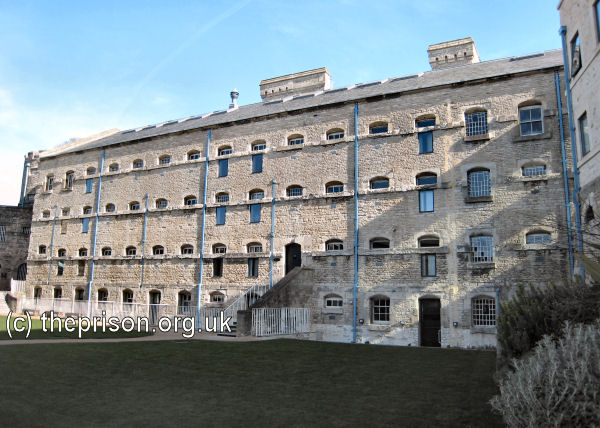
Oxford County Hall, 2009. © Peter Higginbotham
The prison buildings were enlarged in 1876. Following the nationalisation of the prison system in 1878, the establishment became Her Majesty's prison Oxford.
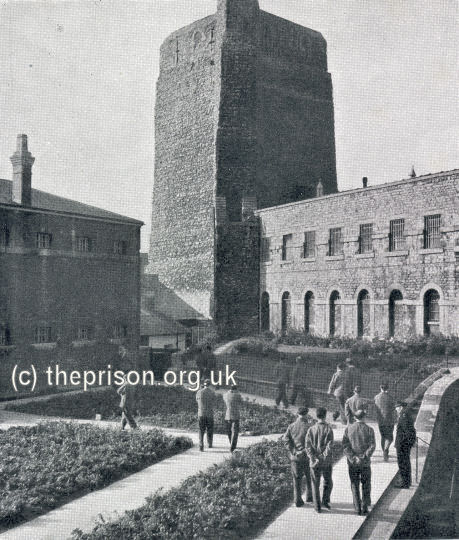
Former HMP Oxford, 2009. © Peter Higginbotham
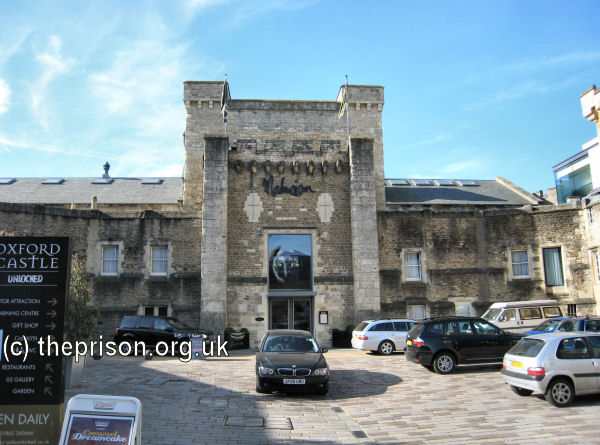
HMP Oxford entrance gate, c.1911. © Peter Higginbotham

Former HMP Oxford entrance, 2009. © Peter Higginbotham
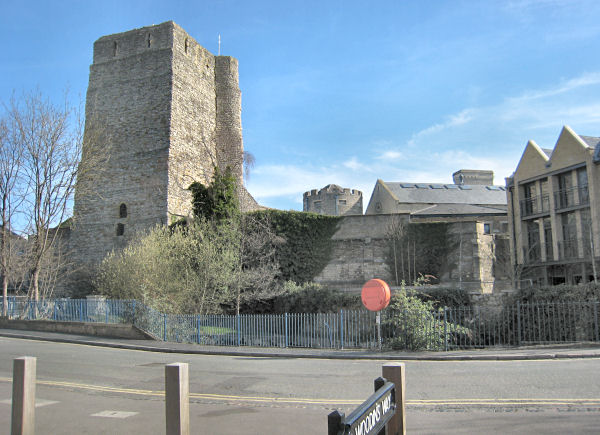
Former HMP Oxford from the south-east, 2009. © Peter Higginbotham
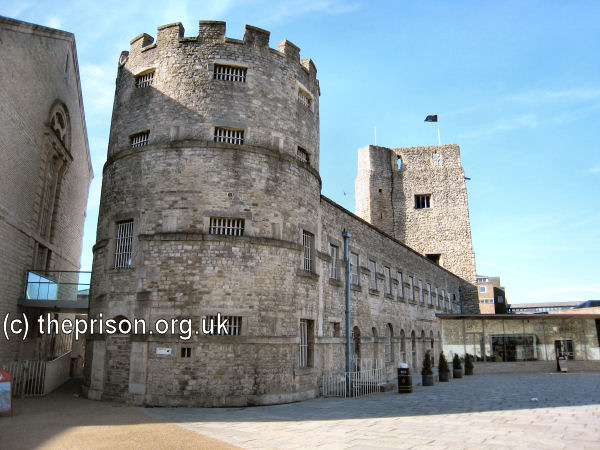
Former HMP Oxford main from the north-east, 2009. © Peter Higginbotham
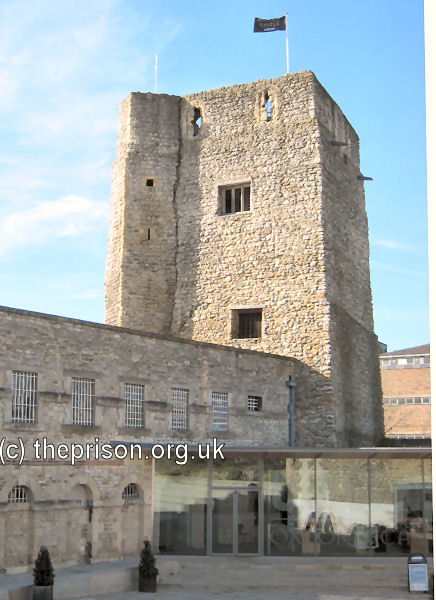
Former HMP Oxford St George's Tower from the north-east, 2009. © Peter Higginbotham

Former HMP Oxford main yard from the south-east, 2009. © Peter Higginbotham

Former HMP Oxford cell block from the south, 2009. © Peter Higginbotham
The prison closed in 1996. Most of the old buildings survive, the castle section now a heritage attraction, and the main cell block converted to the prison-themed Malmaison Hotel.
Records
Note: many repositories impose a closure period of up to 100 years for records identifying individuals. Before travelling a long distance, always check that the records you want to consult will be available.
- Oxfordshire History Centre, St Luke's Church, Temple Road, Cowley, Oxford OX4 2EX.
- The National Archives, Kew, Richmond, Surrey, TW9 4DU. Has a wide variety of crime and prison records going back to the 1770s, including calendars of prisoners, prison registers and criminal registers.
- Find My Past has digitized many of the National Archives' prison records, including prisoner-of-war records, plus a variety of local records including Manchester, York and Plymouth. More information.
- Prison-related records on
Ancestry UK
include Prison Commission Records, 1770-1951
, and local records from London, Swansea, Gloucesterhire and West Yorkshire. More information.
- The Genealogist also has a number of National Archives' prison records. More information.
Census
Bibliography
- Hassall, T.G. Excavations at Oxford Castle, I965-I973 in Oxoniensia, XLI (1976) 232-309.
- Higginbotham, Peter The Prison Cookbook: A History of the English Prison and its Food (2010, The History Press)
- Brodie, A. Behind Bars - The Hidden Architecture of England's Prisons (2000, English Heritage)
- Brodie, A., Croom, J. & Davies, J.O. English Prisons: An Architectural History (2002, English Heritage)
- Harding, C., Hines, B., Ireland, R., Rawlings, P. Imprisonment in England and Wales (1985, Croom Helm)
- McConville, Sean A History of English Prison Administration: Volume I 1750-1877 (1981, Routledge & Kegan Paul)
- Morris, N. and Rothman, D.G. (eds.) The Oxfod History of the Prison (1997, OUP)
- Pugh R.B. Imprisonment in Medieval England (1968, CUP)
Links
- Prison Oracle - resources those involved in present-day UK prisons.
- GOV.UK - UK Government's information on sentencing, probation and support for families.
Except where indicated, this page () © Peter Higginbotham. Contents may not be reproduced without permission.



